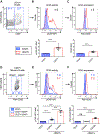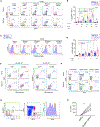Integration of T helper and BCR signals governs enhanced plasma cell differentiation of memory B cells by regulation of CD45 phosphatase activity
- PMID: 34380042
- PMCID: PMC8435664
- DOI: 10.1016/j.celrep.2021.109525
Integration of T helper and BCR signals governs enhanced plasma cell differentiation of memory B cells by regulation of CD45 phosphatase activity
Abstract
Humoral immunity relies on the efficient differentiation of memory B cells (MBCs) into antibody-secreting cells (ASCs). T helper (Th) signals upregulate B cell receptor (BCR) signaling by potentiating Src family kinases through increasing CD45 phosphatase activity (CD45 PA). In this study, we show that high CD45 PA in MBCs enhances BCR signaling and is essential for their effective ASC differentiation. Mechanistically, Th signals upregulate CD45 PA through intensifying the surface binding of a CD45 ligand, Galectin-1. CD45 PA works as a sensor of T cell help and defines high-affinity germinal center (GC) plasma cell (PC) precursors characterized by IRF4 expression in vivo. Increasing T cell help in vitro results in an incremental CD45 PA increase and enhances ASC differentiation by facilitating effective induction of the transcription factors IRF4 and BLIMP1. This study connects Th signals with BCR signaling through Galectin-1-dependent regulation of CD45 PA and provides a mechanism for efficient ASC differentiation of MBCs.
Keywords: B cell memory; B cell receptor signaling; BLIMP1; CD45 phosphatase activity; Galectin-1; IRF4; T cell help; antibody-secreting cell.
Copyright © 2021 The Author(s). Published by Elsevier Inc. All rights reserved.
Conflict of interest statement
Declaration of interests The authors declare no competing interests.
Figures







Similar articles
-
B Cell Receptor Crosslinking Augments Germinal Center B Cell Selection when T Cell Help Is Limiting.Cell Rep. 2018 Nov 6;25(6):1395-1403.e4. doi: 10.1016/j.celrep.2018.10.042. Cell Rep. 2018. PMID: 30403996 Free PMC article.
-
Toll-like receptor agonists synergize with CD40L to induce either proliferation or plasma cell differentiation of mouse B cells.PLoS One. 2011;6(10):e25542. doi: 10.1371/journal.pone.0025542. Epub 2011 Oct 3. PLoS One. 2011. PMID: 21991317 Free PMC article.
-
T-helper signals restore B-cell receptor signaling in autoreactive anergic B cells by upregulating CD45 phosphatase activity.J Allergy Clin Immunol. 2016 Sep;138(3):839-851.e8. doi: 10.1016/j.jaci.2016.01.035. Epub 2016 Apr 4. J Allergy Clin Immunol. 2016. PMID: 27056269
-
Observations on memory B-cell development.Semin Immunol. 1997 Aug;9(4):249-54. doi: 10.1006/smim.1997.0077. Semin Immunol. 1997. PMID: 9237931 Review.
-
BCR Affinity Influences T-B Interactions and B Cell Development in Secondary Lymphoid Organs.Front Immunol. 2021 Jul 26;12:703918. doi: 10.3389/fimmu.2021.703918. eCollection 2021. Front Immunol. 2021. PMID: 34381455 Free PMC article. Review.
Cited by
-
Tumor-secreted galectin-3 suppresses antitumor response by inducing IL-10+ B cells.J Immunother Cancer. 2025 May 31;13(5):e011445. doi: 10.1136/jitc-2024-011445. J Immunother Cancer. 2025. PMID: 40449954 Free PMC article.
-
CD38 regulates chronic lymphocytic leukemia proliferation via CD45 phosphatase activity.Mol Ther Oncol. 2024 Jun 24;32(3):200841. doi: 10.1016/j.omton.2024.200841. eCollection 2024 Sep 19. Mol Ther Oncol. 2024. PMID: 39474602 Free PMC article.
-
Inhibition of CD45-specific phosphatase activity restores the differentiation potential of aged mesenchymal stromal cells: implications in regenerative medicine.Biol Res. 2025 May 2;58(1):24. doi: 10.1186/s40659-025-00603-8. Biol Res. 2025. PMID: 40312428 Free PMC article.
-
Clinical significance of CD45 and CD200 expression in newly diagnosed multiple myeloma patients.Zhong Nan Da Xue Xue Bao Yi Xue Ban. 2025 Apr 28;50(4):545-559. doi: 10.11817/j.issn.1672-7347.2025.240154. Zhong Nan Da Xue Xue Bao Yi Xue Ban. 2025. PMID: 40785670 Free PMC article.
-
Tyrosine Kinase Inhibitors Target B Lymphocytes.Biomolecules. 2023 Feb 25;13(3):438. doi: 10.3390/biom13030438. Biomolecules. 2023. PMID: 36979373 Free PMC article.
References
-
- Allen CD, Okada T, Tang HL, and Cyster JG (2007). Imaging of germinal center selection events during affinity maturation. Science 315, 528–531. - PubMed
-
- Amano M, Galvan M, He J, and Baum LG (2003). The ST6Gal I sialyltransferase selectively modifies N-glycans on CD45 to negatively regulate galectin-1-induced CD45 clustering, phosphatase modulation, and T cell death. J. Biol. Chem 278, 7469–7475. - PubMed
Publication types
MeSH terms
Substances
Grants and funding
LinkOut - more resources
Full Text Sources
Research Materials
Miscellaneous

